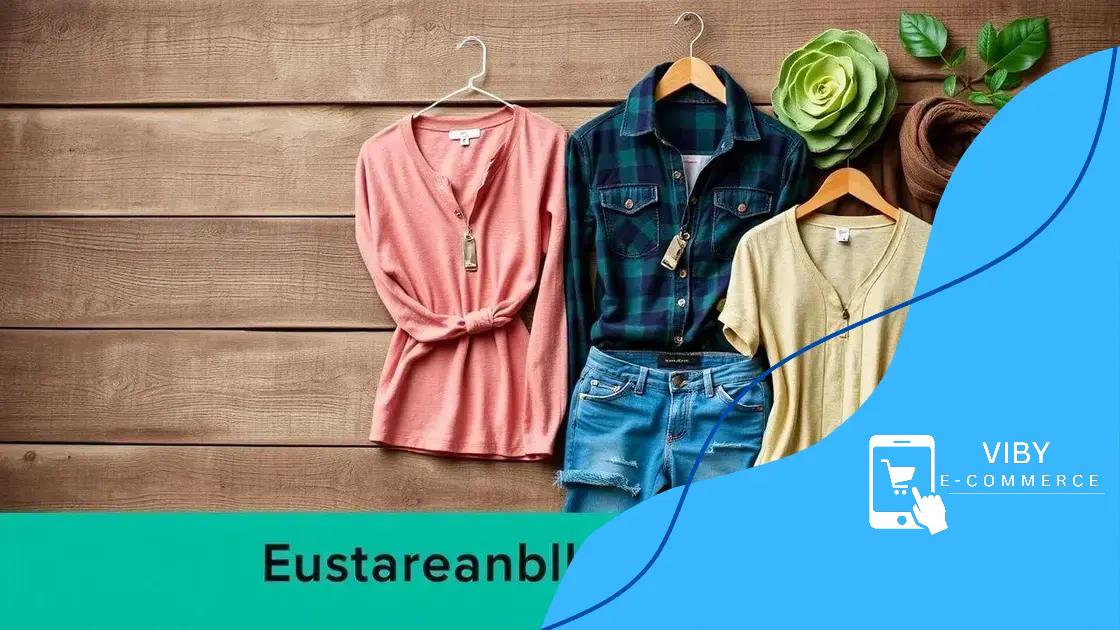Shein’s educational content on eco-friendly fashion choices

Balancing style with sustainability involves choosing eco-friendly materials, supporting ethical brands, and opting for quality clothing to minimize environmental impact while maintaining a fashionable appearance.
Shein’s educational content on eco-friendly fashion choices invites you to rethink your wardrobe. Have you ever wondered how your fashion choices affect the planet? Let’s dive into sustainable practices that can make a difference.
Understanding eco-friendly fashion
Understanding eco-friendly fashion is essential in today’s world. As our planet faces many environmental challenges, making conscious choices in clothing can lead to a significant positive impact. Eco-friendly fashion embodies sustainable practices aimed at reducing environmental harm while promoting ethical production.
What Does Eco-Friendly Fashion Mean?
Eco-friendly fashion focuses on sustainability, ensuring that materials and production processes are designed to minimize waste and pollution. This concept supports the use of organic materials, recycling, and ethical labor practices. By choosing eco-friendly options, consumers can contribute to a more sustainable future.
Key Principles of Sustainable Fashion
- Use of Sustainable Materials: Materials like organic cotton, recycled polyester, and Tencel help reduce the carbon footprint.
- Ethical Labor Practices: Ensuring fair wages and safe working conditions for garment workers.
- Reduced Waste: Encouraging brands to adopt practices that minimize fabric waste and promote recycling.
- Longevity and Quality: Creating durable clothing that lasts longer and reduces the need for frequent replacements.
Another significant aspect of eco-friendly fashion is the awareness around fast fashion. This model promotes quick production cycles, leading to excessive waste and environmental damage. By being informed about the impacts of fast fashion, consumers can make better choices when they shop, opting for quality over quantity.
Purchasing second-hand clothes is a fantastic way to embrace sustainable fashion. Thrift shops and online marketplaces offer opportunities to find unique styles while extending the life cycle of garments. Each time you choose vintage or second-hand clothing, you help decrease demand for new production.
Supporting Eco-Conscious Brands
More brands are stepping up to provide eco-friendly options, driven by consumer awareness. Such brands implement sustainable practices that resonate with environmentally conscious shoppers. They not only focus on the products they offer but also the entire supply chain, ensuring minimal environmental harm.
In summary, embracing eco-friendly fashion is more than a trend; it’s a lifestyle choice that helps protect our planet. By understanding its principles and supporting ethical brands, we all can contribute to a more sustainable fashion industry.
Shein’s role in promoting sustainability
Shein’s role in promoting sustainability has become increasingly significant in the fashion industry. As a major player, Shein recognizes the impact of its practices and is making strides toward incorporating eco-friendly initiatives. This commitment to sustainability influences not only its operations but also its messaging and consumer engagement.
Initiatives for Sustainable Practices
Shein has launched various initiatives aimed at minimizing environmental impact. These programs focus on reducing waste, using sustainable materials, and promoting recycling. By enhancing transparency in their supply chain, Shein helps consumers understand where their clothes come from and how they are made.
Innovative Recycling Programs
- Clothing Recycling: Shein encourages customers to recycle their old clothes through special initiatives, promoting a circular economy.
- Material Innovation: The brand invests in research to develop sustainable materials, reducing reliance on harmful substances.
- Eco-Conscious Packaging: Minimizing packaging waste by using biodegradable or recycled materials is a priority for Shein.
- Green Transportation: Shein is exploring eco-friendly logistics and transportation methods to lower carbon emissions.
Engaging with consumers is crucial for any brand’s sustainability efforts. Shein utilizes social media and campaigns to raise awareness about eco-friendly fashion choices. By educating its audience on the importance of sustainability, Shein empowers shoppers to make informed decisions. This approach helps foster a community focused on responsible fashion consumption.
In addition to promoting sustainability, Shein has committed to supporting various social causes. Their collaborations with non-profit organizations reinforce their goal of making a positive impact, linking community support with environmental responsibility. This strategy not only enhances brand loyalty but also aligns the brand values with those of its customers.
Future Goals in Sustainability
Shein aims to enhance its sustainability goals continually. The future vision includes increasing the percentage of sustainable materials used in production and expanding recycling initiatives. By setting these ambitious targets, Shein is paving the way for more eco-conscious fashion while remaining accessible to a wide audience.
Tips for making conscious fashion choices

Making conscious fashion choices is essential for promoting sustainability in today’s world. By being mindful of the clothes we buy and how they affect the environment, we can all contribute to a healthier planet. Here are some practical tips to help you make better fashion decisions.
Choose Quality Over Quantity
When shopping, think about investing in high-quality pieces that will last longer. Fast fashion often leads to quick wear and tear, contributing to waste. By selecting durable items, you help decrease the demand for new production.
Research Brands
Before making a purchase, research the brands you’re considering. Look for companies that prioritize sustainability and ethical practices. Brands that use eco-friendly materials and provide transparency in their production processes are often more committed to making a positive impact.
- Check Certifications: Seek certifications like GOTS or Fair Trade to ensure the brand meets specific sustainability standards.
- Read Reviews: Customer reviews can provide insight into a brand’s quality and ethical practices.
- Follow Brand Stories: Many brands share their sustainability journeys on social media, offering valuable information about their values and practices.
Additionally, consider the versatility of your wardrobe. Pieces that can be styled in multiple ways are more valuable because they can be worn for different occasions. This reduces the need to buy more clothes and encourages creativity in outfit choices.
Embrace Second-Hand Shopping
Buying second-hand clothes is another excellent way to make conscious choices. Thrift stores and online resale platforms offer unique styles without contributing to new garment production. Every second-hand purchase supports a circular economy while saving you money.
Be Mindful of Your Fashion Habits
Before shopping, ask yourself if you truly need a new item or if your wardrobe can be creatively styled with what you already have. Developing a habit of mindful shopping can significantly reduce impulse purchases that lead to waste.
Another tip is to host clothing swaps with friends. This fun activity not only refreshes your wardrobe but also promotes sharing and reduces clothing waste. It’s an excellent way to explore different styles without directly buying new items.
Support Local and Sustainable Brands
Whenever possible, support local businesses that focus on sustainable practices. These brands often produce smaller collections, which can lead to less waste compared to larger retailers. By choosing local, you also help strengthen your community’s economy.
The impact of fast fashion on the environment
The impact of fast fashion on the environment is profound and concerning. This business model promotes the rapid production of cheap clothing, leading to waste and significant environmental damage. Fast fashion encourages consumers to buy more, often resulting in clothes being discarded after only a few wears.
High Levels of Waste
One of the most significant issues with fast fashion is the sheer amount of waste it generates. Millions of tons of clothing end up in landfills every year. Many of these garments are made from synthetic materials that can take hundreds of years to decompose. The cycle of producing more and discarding quickly contributes to pollution and resource depletion.
Resource Consumption
Fast fashion brands rely heavily on finite resources. For instance, cotton requires large amounts of water and pesticides for growth, leading to water shortages and harmful chemical runoff. The manufacturing process of synthetic fabrics uses harmful chemicals and fossil fuels, which release toxins into the environment.
- Water Usage: The fashion industry is one of the largest consumers of freshwater globally, affecting local water sources.
- Soil Degradation: Intensive farming practices in cotton production can lead to soil depletion and erosion.
- Air Pollution: Factories often emit pollutants, harming the air quality in surrounding communities.
- Carbon Footprint: The transportation of garments around the globe significantly increases carbon emissions.
Moreover, fast fashion promotes a culture of disposability. Consumers are often conditioned to value low prices over quality. This not only affects purchasing habits but also encourages a throwaway mindset, where clothing is seen as easily replaceable rather than a valued item. Efforts to address these issues include raising consumer awareness and encouraging responsible buying habits.
Social Consequences
The negative impacts of fast fashion also extend to social issues, especially in developing countries. Workers in garment factories often face poor working conditions, long hours, and low wages. Many brands prioritize profit over ethical labor practices, leading to exploitation and human rights violations.
Addressing the environmental impact of fast fashion requires collective action from consumers, brands, and policymakers. Supporting sustainable brands and choosing to shop mindfully can drive change. Everyone can help reduce waste and promote environmental responsibility.
Balancing style with sustainability
Balancing style with sustainability is crucial in the modern fashion landscape. Many consumers want to look good without harming the environment. Fortunately, it is possible to achieve both by making informed choices and embracing sustainable practices.
Understand Your Style Needs
First, to maintain a stylish wardrobe, it is essential to know your personal style. Identifying your preferred colors, cuts, and fabrics can help you make thoughtful purchases. By understanding what you love, you can focus on quality pieces that enhance your wardrobe and are versatile.
Invest in Sustainable Fashion
Choosing sustainable brands is a graceful way to blend fashion with eco-friendliness. Many brands now prioritize sustainability by using organic materials and ethical production processes. When shopping, look for certifications that indicate environmentally friendly practices. Supporting brands that align with your values encourages more companies to adopt similar practices.
- Look for Eco-Friendly Materials: Fabrics like organic cotton, hemp, and Tencel are sustainable options that are stylish and durable.
- Focus on Timeless Pieces: Invest in classic styles that never go out of fashion, reducing the need for frequent purchases.
- Consider Local Brands: Local designers often practice ethical production and contribute to the local economy.
- Participate in Clothing Swaps: Swapping clothes is a fun way to refresh your wardrobe without buying new items.
Incorporating second-hand and vintage pieces can also elevate your style while supporting sustainability. These unique items allow for creative expression and can often be found at thrift stores or online marketplaces. Embracing individuality in your clothing choices promotes a personal touch while helping the planet.
Mixing New with Old
Learning to mix and match new sustainable items with older clothes can create a fresh yet eco-conscious look. Pairing a high-quality, sustainable top with vintage jeans can be both chic and environmentally friendly. This approach not only maintains style but also reduces waste by maximizing the use of what you already own.
Finally, maintain your clothing as best as possible to help extend its life. Proper care, like washing in cold water and air drying, protects fabrics and helps your clothes last longer. Staying fashionable while being kind to the earth is a matter of conscious decisions and mindful actions.
FAQ – Frequently Asked Questions about Balancing Style with Sustainability
How can I make more sustainable fashion choices?
You can choose sustainable brands, shop second-hand, and prioritize quality over quantity when buying clothes.
What are eco-friendly materials I should look for?
Look for materials like organic cotton, linen, recycled polyester, and Tencel that have a lower environmental impact.
Why is it important to support local fashion brands?
Supporting local brands helps the community, reduces transportation emissions, and often results in more ethical production practices.
How can I maintain my clothing to make it last longer?
Wash clothes in cold water, air dry when possible, and follow care labels to extend the life of your garments.





